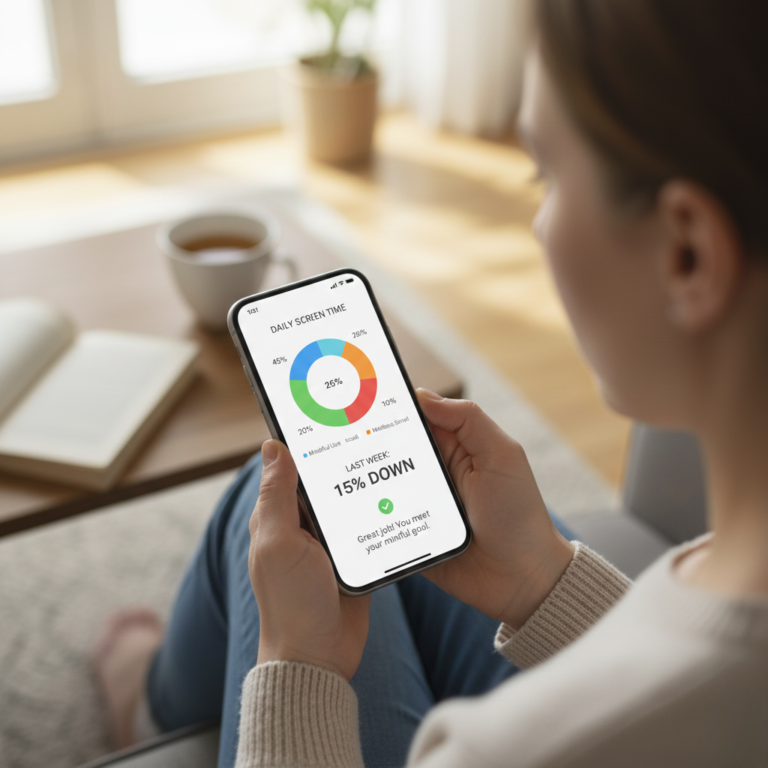
How do you start your day? If you’re like most people, you probably reach for your phone within minutes (or even seconds) of waking up. You check emails, scroll through social media, and catch up on the news – all before you’ve even gotten out of bed. While this might seem like a harmless way to ease into the day, it’s actually setting you up for a day of reactivity, distraction, and stress.
This blog post will guide you through the process of building a mindful morning routine without screens, helping you cultivate a sense of calm, focus, and intention that will positively impact the rest of your day. Imagine starting your day feeling centered and empowered, instead of overwhelmed and depleted. Are you ready to transform your mornings?

The Problem with Screen-Filled Mornings
Before we dive into the “how,” let’s explore the why. Why is starting your day with screens so detrimental?
The Cortisol Spike
Checking your phone first thing in the morning triggers a release of cortisol, the stress hormone. This puts your body into “fight-or-flight” mode, making you feel anxious and on edge. Even seemingly innocuous notifications or emails can trigger this stress response.
The Dopamine Trap
Social media and other apps are designed to be addictive, hijacking your brain’s reward system with dopamine hits. Starting your day with these dopamine triggers sets you up for a day of craving more, making it harder to focus on tasks that require sustained attention.
The Reactivity Mindset
When you start your day reacting to external stimuli (emails, notifications, news headlines), you’re training your brain to be reactive rather than proactive. You’re letting the outside world dictate your mood and priorities, instead of setting your own intentions for the day.
The Comparison Game
Social media, in particular, can fuel the “comparison game,” leading to feelings of inadequacy and self-doubt. Starting your day by comparing yourself to others is a surefire way to sabotage your mood and confidence.
Step 1: Prepare the Night Before
A mindful morning routine actually begins the night before. Preparing your environment and setting your intentions the previous evening makes it much easier to resist the temptation to reach for your phone in the morning.
The “Digital Sunset”
Establish a “digital sunset” at least an hour before bedtime. This means putting away all screens (phones, tablets, computers, TVs) to allow your body to naturally produce melatonin, the hormone that regulates sleep. (Statistic: Include a statistic about the impact of blue light on sleep. Source: Potential source – National Sleep Foundation, research studies on blue light and sleep)
Charge Your Phone Outside Your Bedroom
This is a crucial step. If your phone is within arm’s reach, the temptation to check it will be much stronger. Charge your phone in another room, or at least across the room from your bed. Consider investing in a traditional alarm clock.
Set Your Intention for the Morning
Before you go to sleep, take a few moments to visualize your ideal morning routine. What activities would make you feel calm, centered, and energized? Write down your intentions for the morning, for example: “Tomorrow morning, I will wake up, drink a glass of water, meditate for 10 minutes, and stretch.”
Prepare for activities.
If you plan to journal, exercise, or do another activity in the morning, make it easy for yourself to do.
Step 2: Wake Up Mindfully
The first few moments after waking up are crucial for setting the tone for your day.
Resist the Urge to Reach for Your Phone
This is the hardest part, but it’s essential. Remind yourself of your intentions and the benefits of a screen-free morning. Take a few deep breaths and focus on the feeling of being present in your body.
Hydrate
Drink a large glass of water as soon as you wake up. This rehydrates your body after sleep and helps kickstart your metabolism. You can add lemon or lime for extra flavor and benefits.
Let in Natural Light
Open your curtains or blinds to let in natural light. Sunlight helps regulate your circadian rhythm and signals to your brain that it’s time to wake up.
Step 3: Cultivate Calm and Focus
Now it’s time to engage in activities that nourish your mind and body, setting a positive tone for the day.
Meditation or Mindfulness Practice
Even just 5-10 minutes of meditation or mindfulness practice can have a profound impact on your mental state. There are many free guided meditation apps available (but use them after your morning routine, not before!). You can also simply sit quietly and focus on your breath.
Gentle Movement
Engage in some gentle movement, such as stretching, yoga, or a short walk. This helps to awaken your body and increase blood flow. (Internal Linking Opportunity: Link to a short morning yoga routine video)
Journaling
Journaling is a powerful tool for self-reflection and intention-setting. You can write about your dreams, your goals, your gratitude, or anything else that comes to mind.
- Gratitude Journaling: List 3-5 things you’re grateful for. This simple practice can shift your focus to the positive and boost your mood.
- Morning Pages: Write stream-of-consciousness for a set amount of time (e.g., 10-15 minutes). This can help clear your mind and unlock creativity.
- Goal Setting: Write down your top 1-3 priorities for the day. This helps you focus your energy and attention on what matters most.
Affirmations
Repeat positive affirmations to yourself, either silently or out loud. Affirmations can help reprogram your subconscious mind and boost your confidence. Examples:
- “I am capable and strong.”
- “I am grateful for this day.”
- “I choose to focus on the positive.”
Step 4: Nourish Your Body
Fuel your body with a healthy breakfast without the distraction of screens.
Mindful Eating
Eat your breakfast slowly and mindfully, paying attention to the taste, texture, and aroma of your food. Avoid multitasking (like reading emails or watching TV) while you eat.
Choose Nourishing Foods
Opt for a breakfast that provides sustained energy and supports your overall well-being. This might include whole grains, fruits, vegetables, protein, and healthy fats.
Step 5: Ease into Your Day
Once you’ve completed your mindful morning routine, you can gradually introduce technology back into your day, but do so intentionally.
Check Emails and Messages Strategically
Instead of constantly checking your inbox throughout the day, set aside specific times for email and message management. This helps you avoid getting sucked into a reactive mode.
Use Technology Mindfully
Be conscious of how you’re using technology. Are you using it to connect with others, learn something new, or create something meaningful? Or are you mindlessly scrolling and wasting time?
Set Boundaries
Establish clear boundaries around your technology use throughout the day. This might include turning off notifications, setting time limits for social media, or designating specific “tech-free” zones in your home.
Conclusion: Reclaim Your Mornings, Transform Your Life
Building a mindful morning routine without screens is a powerful investment in your well-being. It’s a way to start your day with intention, cultivate calm and focus, and set yourself up for a more productive and fulfilling day. It may take some time and effort to establish this new habit, but the benefits are well worth it. You deserve a morning that nourishes your mind, body, and soul.
Commit to trying a screen-free morning routine for one week. Start with just a few of the steps outlined above and gradually incorporate more as you become comfortable. Share your experience and any tips you discover in the comments below!
Frequently Asked Questions (FAQs)
Q1: What if I wake up in the middle of the night and can’t fall back asleep?
A1: Avoid reaching for your phone! The blue light will make it even harder to fall back asleep. Instead, try deep breathing exercises, meditation, or reading a physical book (with a dim light).
Q2: I use my phone as an alarm. How can I avoid checking it in the morning?
A2: Invest in a traditional alarm clock, or use a “sunrise alarm clock” that gradually wakes you up with light.
Q3: I feel anxious without my phone. What should I do?
A3: This is a common feeling, especially in the beginning. Acknowledge your anxiety, but don’t give in to the urge to check your phone. Practice deep breathing, mindfulness, or other relaxation techniques.
Q4: What if I have an emergency and need to be reachable?
A4: You can set your phone to “Do Not Disturb” mode but allow calls from specific contacts (e.g., family members) to come through.
Q5: How long will it take to see the benefits of a screen free morning?
A5: Most people feel the difference in as little as a week.






